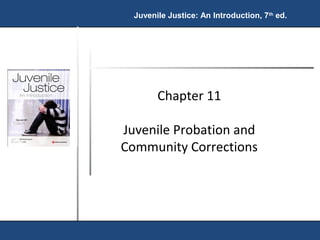This chapter discusses juvenile probation and community corrections. It notes that over 600,000 juveniles were processed through probation in 2007. Probation investigations examine legal details of an offense as well as a youth's social history. Conditions of probation typically include regular check-ins, obeying the law, and attending school. Recent approaches to probation emphasize balanced accountability and rehabilitation, though some favor tougher punitive models. Effective interventions include cognitive behavioral therapy and social learning programs, while ineffectual approaches often focus solely on deterrence without treatment.

















